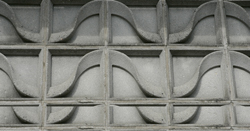Because they’re still there
Duo shares a commitment to Philadelphia’s architectural wallflowers
Because they’re still there |
| Duo shares a commitment to Philadelphia’s architectural wallflowers |
| Friday, April 10, 2009 |
| CONTACT: |
| "Sometimes it’s a strange curve or shape, a great sign on top of a very traditional brick structure or unique lettering,” said Betsy Manning, a Temple University photographer, describing what catches her eye when she drives around the city. “Sometimes a friend says, ‘I just saw the ugliest building I’ve ever seen; you’re gonna love it.’ That happens to me all the time.” Manning is talking about what she calls the “architectural wallflowers” of Philadelphia, a term she coined to refer to those forgotten structures from the middle of the 20th century that pepper Philadelphia’s landscape. “They blend in. They’re not noticed, not recognized. But they’re terrific,” she said. You will not find Manning’s wallflowers listed among the roughly one to two dozen architecturally significant, and therefore well-preserved, Modernist landmarks that our city boasts. |
| “There are too many structures that are unrecognized — or worse, destroyed — because they lack the pedigree of their famous counterparts,” said Manning. “We are guilty of architectural myopia. There are a vast amount of contemporary structures, facades, details and motifs all around us that need to be researched, documented and saved.” Manning has undertaken a project to photograph her wallflowers. Libraries, hospitals, schools, churches, municipal buildings, police stations, recreation centers and private residences, built between 1930 and 1970, are all represented in her database of 300 (and growing) entries, which also tracks information such as the architect’s name and date the property was constructed. |
 Photo by Betsy Manning
“What appeals to me in the architecture of this period is the use of repetition — the simplicity of the grid or when a pattern is so tight it becomes a singular design element.” —Besty Manning
|
|
|
|
|
According to Ken Finkel, distinguished lecturer in American Studies at Temple’s College of Liberal Arts and former executive director of arts and culture at WHYY, these wallflowers tell us a lot about the city before deindustrialization. “There was an optimism that the city was going places, but that didn’t happen. Industrial Philadelphia collapsed and has only found its footing in the last decade. Of course, Temple is part of that rise,” he said. |